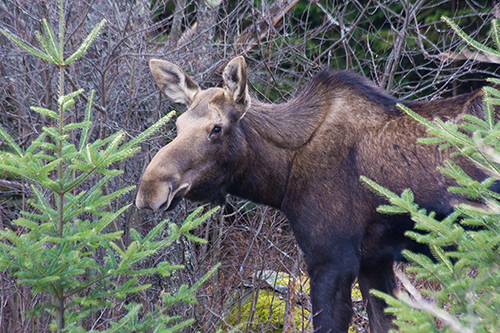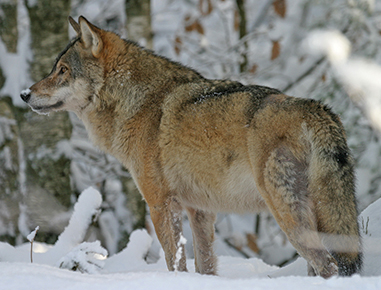
We Shouldn't Hunt Moose
By: Guest contributor - John Davis
November 1, 2016
This article first ran in the September/October edition of the Adirondack Explorer The people of New York were right to welcome moose back, and we are right to continue protecting them. State officials should not now, or anytime soon, open a hunting season on moose. As with so many wildlife-conservation priorities, reasons for continuing to protect moose include ecological, cultural, recreational, aesthetic, and moral.
The people of New York were right to welcome moose back, and we are right to continue protecting them. State officials should not now, or anytime soon, open a hunting season on moose. As with so many wildlife-conservation priorities, reasons for continuing to protect moose include ecological, cultural, recreational, aesthetic, and moral.
Concerned New York residents should weigh in on this issue soon. This spring the State Senate passed a bill allowing the Department of Conservation (DEC) to institute regulations for hunting of moose. The bill has not passed the Assembly; and we should stop it before it does. Let DEC and your Assembly members know of your concerns for our region’s biggest land animal.
Ecologically, the natural recolonization of New York by moose is proving a wonderful rewilding success story, with which we should not interfere. Moose have not yet nearly reached carrying capacity, in lush, wetland-dotted northern New York. The Adirondack Park, in particular, can support many more moose. New York’s Adirondack Park could become an important southern outpost for moose in a warming world. We still have here in the Park extensive northern hardwood forest, boreal spruce/fir forest, and boreal bogs—habitats that provide moose abundant browse and cool temperatures. These habitats are scarce farther south and will grow scarcer still with climate chaos and wildland fragmentation.
Moreover, New York is the one state in the Northeast with a significant moose population (estimated by DEC in 2010 as five hundred to eight hundred animals) but still granting the world’s biggest deer full protection. Maine, New Hampshire, and Vermont all have opened hunting seasons on moose. Safe strongholds, where full protection is awarded, are crucial for wide-ranging and sensitive species. Arguably, the Adirondack Park offers animals and plants that may be sensitive to human-wrought changes, particularly habitat fragmentation and climate chaos, the wildest and most secure habitat in the East.
If and when moose near carrying capacity, their natural and most effective pr edator— governor of ungulate behavior and numbers, protector of plant communities—would be the wolf. Northern Maine has reached this state, and urgently needs wolves back in place to keep moose and the plants they browse in balance. Hunting by modern humans seldom matches the effectiveness of natural predation, as we tend to shoot strong bulls (or bucks), rather than culling weaker members of both sexes.
edator— governor of ungulate behavior and numbers, protector of plant communities—would be the wolf. Northern Maine has reached this state, and urgently needs wolves back in place to keep moose and the plants they browse in balance. Hunting by modern humans seldom matches the effectiveness of natural predation, as we tend to shoot strong bulls (or bucks), rather than culling weaker members of both sexes.
Moreover, we have in northern New York an illuminating experiment that we may do well to let play out. Coyotes have interbred with wolves, producing a bigger, more wolf-like eastern coyote, or coy-wolf, which is hunting in packs and occasionally taking down whitetailed deer, though rarely moose (and not deer as often as would be best for plant communities: over-browsing may be a growing problem as our winters weaken and deer numbers stay unnaturally high).
|
Of equal concern ecologically is that moose recovery in our region is far from secure. With warming climate, moose ticks are proliferating in Maine, Minnesota, and perhaps other places, but not yet in New York, thankfully. Sometimes these blood-sucking parasites almost literally pester the big ungulates to death. Plus, with global overheating, summers in some parts of moose range are becoming stressfully hot for this boreal mammal. Moose do not need another source of stress in the form of guns. Culturally and morally, we need to learn to live and let live, to let wild things be, and not always feel compelled to manage them. Government wildlife agencies tend to have cultures of management and harvesting, rather than of appreciation and coexistence. Instituting a hunt—or a “harvest,” as it would likely be called—of moose would further entrench that outmoded exploitative management style. Recreationally and economically, people love seeing moose, alive, and will travel long distances and use local services, for the opportunity. As John Laundre and Chris Spatz showed in their article “Yellowstone East: The Economic Benefits of Restoring the Adirondack Ecosystem with Native Wildlife” (Cougar Rewilding Foundation newsletter, April 2015), wildlife watching is now a bigger economic force than is hunting. Rewilding the Adirondacks, by allowing full recovery of moose and the reintroduction of other extirpated wildlife, particularly cougar and wolf, would make the Adirondack Park a world-class wildlife watching destination, an eco-tourist draw on par with Yellowstone National Park. Aesthetically and ethically, we are a richer, nobler people to the extent we welcome and admire our wild neighbors. Moose make our forests wilder, more beautiful. Let’s let them live, and welcome home their original predators, too. |
|
|||





